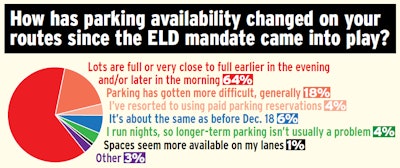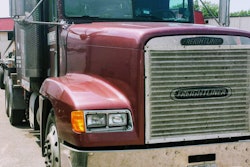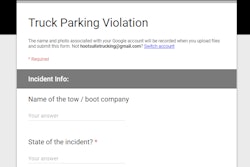 MUSICAL CHAIRS: “The song is getting shorter and shorter, and chairs are being taken away in the middle of the song.” –Tyler Tanaka, Pilot Flying J
MUSICAL CHAIRS: “The song is getting shorter and shorter, and chairs are being taken away in the middle of the song.” –Tyler Tanaka, Pilot Flying JThe electronic logging device mandate has had the unintended effect of adding new pressure to the parking situation along busy corridors across the nation.
Truck stop chains seem to have anticipated the swelling demand, some converting formerly open spaces to pay-to-park spots available only with reservations. While some drivers frown on the practice – denouncing reservation systems as a means to pad revenue at the expense of loyal customers – truck stop chains insist the reservation option benefits drivers.
Tyler Tanaka, director of digital and innovation at Pilot Flying J, compares the situation to playing musical chairs. “The song is getting shorter and shorter, and chairs are being taken away in the middle of the song. It puts artificial pressure on certain times of the day and makes it harder and harder for drivers to find spots.”
The reservation system enables drivers to plan better and helps mitigate the stress associated with finding parking, he says.
Since late 2017, TA/Petro has seen its share of reserved spaces grow a few percentage points to 12 percent of its total spaces, says company spokesperson Tom Liutkus. That’s due in part to the ELD mandate, he says, and “a shift in drivers understanding that this could help them.”
While truck stop pay-to-park without a fuel purchase was common in past decades, it fell out of fashion as chains competed for business. Now some lots are more than half-allocated to reserved spaces, and prices appear to be climbing. TA/Petro’s reserved pricing starts at $12 and ranges to $18, covering a 24-hour period. Prices for reserved spaces at Pilot Flying J stops run about the same, though they vary by timing and location.
Commenter Lynn Rhoades on OverderiveOnline.com, echoing similar comments online, called the paid parking “one more way for truck stops to increase their revenue at the expense of the drivers. … Truckers are just cash cows to the stockholders.”
Liutkus acknowledges that some drivers still have an issue with paid reservations. Yet owner-operators who use the system “will tell you it’s a godsend,” he says, noting they often pass the costs on to customers and see their available drive time boosted.
Owner-operator Rico Muhammad hauls reefer freight between his two-truck fleet’s home in the Atlanta area and North Carolina. At truck stops along the I-85 corridor at night, “it’s a real corn maze to work your way through the lots,” he says. At rest areas along the route, which he often runs overnight, “I’m seeing overflow on both the entrance and exit sides,” with truckers parked on ramps. “I can only imagine that for the guys who don’t have a regular route, it’s really getting rough.”
Rigid application of the hours of service rule under the ELD mandate only compounds the pressure on parking, especially on heavily trafficked corridors and around metro areas. With truckers subject to the 10-hour off-duty period and the majority of them running days, that means parking spaces are occupied longer around sunset and daybreak. Nearly seven in 10 Overdrive readers reported that as the principal feature of the post-ELD mandate’s parking reality.
 Few readers are using paid parking reservations as a solution to the growing parking problem.
Few readers are using paid parking reservations as a solution to the growing parking problem.The Federal Motor Carrier Safety Administration’s rep Sharon Worthy did not respond to a request for comment on whether this development was foreseen by regulators as a potential consequence of the e-log shift.
The Commercial Vehicle Safety Alliance asked its state enforcement members whether officers had seen changes in parking availability with truckers’ adjustment to ELDs. Sgt. Walter Newton of Delaware’s truck enforcement unit noted there’s been no increase in the frequency of drivers stopping to ask for long-term parking at two weigh stations along I-95, a practice typically not allowed.
 This hotshot car hauler was parked on an I-40 rest area’s ramp shoulder in middle Tennessee around 9 a.m. Other truckers also occupied ramp areas as central parking places remained nearly full. Many truckers say peak parking times have broadened since the ELD mandate went into effect.
This hotshot car hauler was parked on an I-40 rest area’s ramp shoulder in middle Tennessee around 9 a.m. Other truckers also occupied ramp areas as central parking places remained nearly full. Many truckers say peak parking times have broadened since the ELD mandate went into effect.What has changed, though, is increased awareness of the parking issue among drivers and enforcement personnel, he says. At the top, FMCSA recently announced intentions to conduct another survey about parking needs as part of its compliance with the Jason’s Law provisions in the 2012 MAP-21 highway bill.
Newton says Delaware has large parking facilities – a rest area and a truck stop – downstream from their scale locations where drivers can go. Even those facilities can fill up at peak times.
The widely-used Trucker Path app allows users to report parking availability (“Lots of spots,” “Some spots,” and “Lot full”) at most any facility around the nation. At Overdrive’s request, Trucker Path’s Sam Bokher analyzed driver reports in March and April of 2017, comparing them to the same months this year, after the ELD mandate came into play.
“There isn’t much difference between 2017 and 2018” in the driver-report data, Bokher says. But when he analyzed the number of searches for parking information from within the app, it told a different story, one that’s of a piece with Sergeant Newton’s contention that the real change is in awareness of parking issues. Increased operational planning around parking, too, seems to be a reality. While Trucker Path’s user base increased just 20 percent over the time period analyzed, parking-info look-ups as drivers planned stops had nearly doubled, with a very steep curve upward in search numbers between 3 and 8 p.m. Eastern time.
Owner-operator Tilden Curl, who specializes in step deck freight along the congested I-5 corridor between his Washington State home and Northern California, has seen the peak extension phenomenon firsthand. Before the mandate, he says, “things were really starting to get pretty full at rest areas and other places” by 8 or 9 p.m. Now “you have to plan your schedule to be parked by six in the evening.”
Next in this series: The extent of expanded paid parking reservations after the ELD mandate











